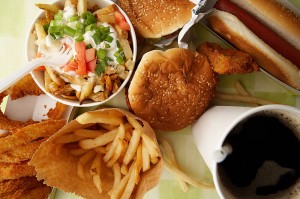http://www.mayoclinic.com/health/cholesterol/CL00002
 Can a bowl of oatmeal help lower your cholesterol? How about a handful of walnuts or even a baked potato topped with some heart-healthy margarine? A few simple tweaks to your diet — like these — may be enough to lower your cholesterol to a healthy level and help you stay off medications.
Can a bowl of oatmeal help lower your cholesterol? How about a handful of walnuts or even a baked potato topped with some heart-healthy margarine? A few simple tweaks to your diet — like these — may be enough to lower your cholesterol to a healthy level and help you stay off medications.1. Oatmeal, oat bran and high-fiber foods
Oatmeal contains soluble fiber, which reduces your low-density lipoprotein (LDL), the “bad” cholesterol. Soluble fiber is also found in such foods as kidney beans, apples, pears, barley and prunes.
Soluble fiber can reduce the absorption of cholesterol into your bloodstream. Five to 10 grams or more of soluble fiber a day decreases your total and LDL cholesterol. Eating 1 1/2 cups of cooked oatmeal provides 6 grams of fiber. If you add fruit, such as bananas, you’ll add about 4 more grams of fiber. To mix it up a little, try steel-cut oatmeal or cold cereal made with oatmeal or oat bran.
2. Walnuts, almonds and other nuts
Walnuts, almonds and other nuts can reduce blood cholesterol. Rich in polyunsaturated fatty acids, walnuts also help keep blood vessels healthy.
According to the Food and Drug Administration, eating about a handful (1.5 ounces, or 42.5 grams) a day of most nuts, such as almonds, hazelnuts, peanuts, pecans, some pine nuts, pistachio nuts and walnuts, may reduce your risk of heart disease. Just make sure the nuts you eat aren’t salted or coated with sugar.
All nuts are high in calories, so a handful will do. To avoid eating too many nuts and gaining weight, replace foods high in saturated fat with nuts. For example, instead of using cheese, meat or croutons in your salad, add a handful of walnuts or almonds.
3. Olive oil
Olive oil contains a potent mix of antioxidants that can lower your “bad” (LDL) cholesterol but leave your “good” (HDL) cholesterol untouched.
The Food and Drug Administration recommends using about 2 tablespoons (23 grams) of olive oil a day in place of other fats in your diet to get its heart-healthy benefits. To add olive oil to your diet, you can saute vegetables in it, add it to a marinade, or mix it with vinegar as a salad dressing. You can also use olive oil as a substitute for butter when basting meat or as a dip for bread. Olive oil is high in calories, so don’t eat more than the recommended amount.
The cholesterol-lowering effects of olive oil are even greater if you choose extra-virgin olive oil, meaning the oil is less processed and contains more heart-healthy antioxidants. But keep in mind that “light” olive oils are usually more processed than extra-virgin or virgin olive oils and are lighter in color, not fat or calories.
4. Foods with added plant sterols or stanols
Foods are now available that have been fortified with sterols or stanols — substances found in plants that help block the absorption of cholesterol.
Margarines, orange juice and yogurt drinks with added plant sterols can help reduce LDL cholesterol by more than 10 percent. The amount of daily plant sterols needed for results is at least 2 grams — which equals about two 8-ounce (237-milliliter) servings of plant sterol-fortified orange juice a day.
Plant sterols or stanols in fortified foods don’t appear to affect levels of triglycerides or of high-density lipoprotein (HDL), the “good” cholesterol.
Other changes to your diet
For any of these foods to provide their benefit, you need to make other changes to your diet and lifestyle.
Cut back on the cholesterol and total fat — especially saturated and trans fats — that you eat. Saturated fats, like those in meat, full-fat dairy products and some oils, raise your total cholesterol. Trans fats, which are sometimes found in margarines and store-bought cookies, crackers and cakes, are particularly bad for your cholesterol levels. Trans fats raise low-density lipoprotein (LDL), the “bad” cholesterol, and lower high-density lipoprotein (HDL), the “good” cholesterol.

